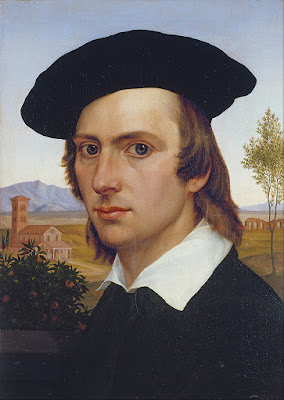 |
| Hans Burgkmair Self-portrait 1517 drawing Kunsthalle, Hamburg (false Dürer monogram added at a later date) |
 |
| Giuseppe Arcimboldo Self-portrait 1570 drawing Národní Galerie, Prague |
"But a far more vexing question remained. Even supposing that a portrait did present a true likeness – as could be assumed in the case of those to be seen on coins and medals – what, if anything, could this tell one about the character of the man or woman whose features were recorded? The question had struck him first in Modena, a month or so before he began to visit the Uffizi with such assiduity. Looking at a bronze coin which portrayed Marcus Agrippa, the powerful collaborator of Augustus in establishing the Roman Empire, Gibbon noted: "I believed that I could read in the features of Agrippa those qualities of frankness, grandeur and simplicity which characterized this respectable man: but observations of this kind, although they have been sanctioned by Addison, strike me as very hollow. Is it so common for a man's soul to be legible in his features? I would like to hear of some ignorant person who, on being shown a head of Nero, would exclaim "There's a scoundrel!" It is so easy for the scholar who already knows that he was one."
– from History and Its Images by Francis Haskell, quoting a journal entry written in 1764 by Edward Gibbon during an Italian research-expedition for The Decline and Fall of the Roman Empire
 |
| Joachim Wtewael Self-portrait 1601 oil on panel Centraal Museum, Utrecht |
 |
| Carel Fabritius Self-portrait 1645 oil on panel Museum Boijmans van Beuningen, Rotterdam |
 |
| Bartholomeus van der Helst Self-portrait 1655 oil on canvas Toledo Museum of Art |
 |
| Michiel van Musscher Self-portrait 1685 oil on canvas Rijksmuseum, Amsterdam |
 |
| Anton Raphael Mengs Self-portrait in youth 1740 drawing Kupferstich Kabinett, Dresden |
 |
| Johan Zoffany Self-portrait as David with the head of Goliath 1756 oil on canvas National Gallery of Victoria, Melbourne |
"French art critics of the 1750s and 1760s were troubled by what seemed to them the highly questionable status of portraiture in their time. One objection frequently raised was that almost all contemporary portraits required the exercise of merely mechanical skills and so were unworthy of serious consideration as works of art. Another objection was that most of the those who commissioned portraits of themselves were relatively obscure and unimportant persons whose likenesses could be of interest only to their friends. But there, was, I suggest, still another source of critical misgiving – the inherent theatricality of the genre. More nakedly and as it were categorically than the conventions of any other genre, those of the portrait call for exhibiting a subject, the sitter, to the public gaze; put another way, the basic action depicted in a portrait is the sitter's presentation of himself or herself to be beheld. It follows that the portrait as a genre was singularly ill equipped to comply with the demand that a painting negate or neutralize the presence of the beholder, a demand I have tried to show became a matter of urgent, if for the most part not fully conscious, concern for French art critics during these years."
– Michael Fried, from Absorption and Theatricality: Painting and Beholder in the Age of Diderot (University of California Press, 1980)
 |
| Allan Ramsay Self-portrait 1756 pastel National Gallery of Scotland, Edinburgh |
 |
| Jean-Baptiste Siméon Chardin Self-portrait 1771 pastel Louvre |
 |
| Johann David Passavant Self-portrait with beret before Roman landscape 1818 oil on panel Städelsches Kunstinstitut, Frankfurt |
 |
| George Richmond Self-portrait 1830s oil on canvas Yale Center for British Art |
 |
| Arnold Böcklin Self-portrait with Death fiddling 1872 oil on canvas Alte Nationalgalerie, Berlin |
 |
| Vincent van Gogh Self-portrait dedicated to Paul Gauguin 1888 oil on canvas Harvard Art Museums |
"That resplending Image thou seest, was made for eternizing the memory of my portraiture, as I was alive."
– William Lithgow, from The Totall Discourse of the Rare Adventures and Painefull Peregrinations of Long Nineteen Yeares Travayles (1632)